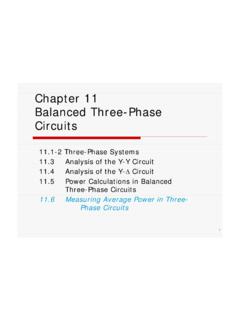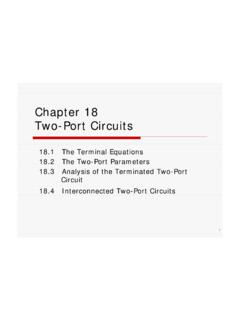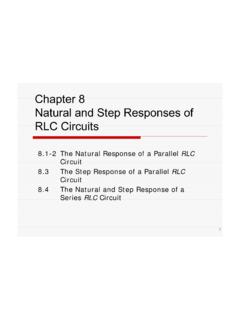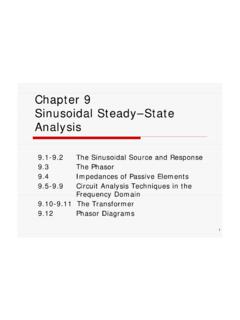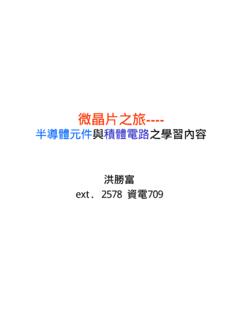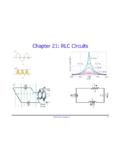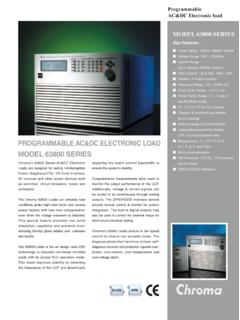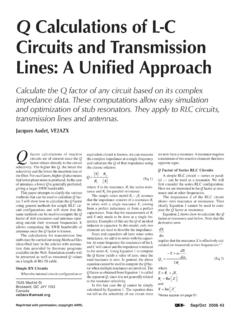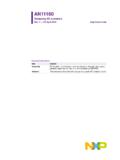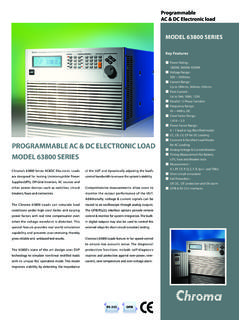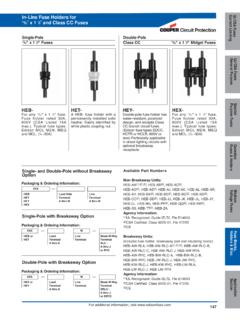Transcription of Chapter 13 The Laplace Transform in Circuit Analysis
1 Chapter 13. The Laplace Transform in Circuit Analysis Circuit Elements in the s Domain Circuit Analysis in the s Domain The Transfer Function and Natural Response The Transfer Function and the Convolution Integral The Transfer Function and the Steady- State Sinusoidal Response The Impulse Function in Circuit Analysis 1. Key points How to represent the initial energy of L, C in the s-domain? Why the functional forms of natural and steady- state responses are determined by the poles of transfer function H(s) and excitation source X(s), respectively? Why the output of an LTI Circuit is the convolution of the input and impulse response? How to interpret the memory of a Circuit by convolution?
2 2. Section Circuit Elements in the s Domain 1. Equivalent elements of R, L, C. 3. A resistor in the s domain iv-relation in the time domain: v (t ) R i (t ). By operational Laplace Transform : L v(t ) L R i (t ) R L i (t ) , V ( s ) R I ( s ). Physical units: V(s) in volt-seconds, I(s) in ampere-seconds. 4. An inductor in the s domain iv-relation in the time domain: d v (t ) L i (t ). dt By operational Laplace Transform : L v (t ) L L i (t ) L L i (t ) , V ( s ) L sI ( s ) I 0 sL I ( s ) LI 0 . initial current 5. Equivalent Circuit of an inductor Series equivalent: Parallel equivalent: Th venin . Norton 6. A capacitor in the s domain iv-relation in the time domain: d i (t ) C v (t ).
3 Dt By operational Laplace Transform : L i (t ) L C v (t ) C L v (t ) , I ( s ) C sV ( s ) V0 sC V ( s ) CV0 . initial voltage 7. Equivalent Circuit of a capacitor Parallel equivalent: Series equivalent: Norton . Th venin 8. Section , Circuit Analysis in the s Domain 1. Procedures 2. Nature response of RC Circuit 3. Step response of RLC Circuit 4. Sinusoidal source 5. MCM. 6. Superposition 9. How to analyze a Circuit in the s-domain? 1. Replacing each Circuit element with its s-domain equivalent. The initial energy in L or C is taken into account by adding independent source in series or parallel with the element impedance. 2. Writing & solving algebraic equations by the same Circuit Analysis techniques developed for resistive networks.
4 3. Obtaining the t-domain solutions by inverse Laplace Transform . 10. Why to operate in the s-domain? It is convenient in solving transient responses of linear, lumped parameter circuits, for the initial conditions have been incorporated into the equivalent Circuit . It is also useful for circuits with multiple essential nodes and meshes, for the simultaneous ODEs have been reduced to simultaneous algebraic equations. It can correctly predict the impulsive response, which is more difficult in the t-domain (Sec. ). 11. Nature response of an RC Circuit (1). Q: i(t), v(t) = ? Replacing the charged capacitor by a Th venin equivalent Circuit in the s-domain.
5 KVL, algebraic equation & solution of I(s): V0 I CV0 V0 R. IR, I ( s ) 1.. s sC 1 RCs s ( RC ). 12. Nature response of an RC Circuit (2). The t-domain solution is obtained by inverse Laplace Transform : 1 V0 R V0 t ( RC ) 1 1 . i (t ) L 1 . e L . s ( RC ) R s . V0 t ( RC ). e u(t ). R. i(0+) = V0/R, which is true for vC(0+) = vC(0-) = V0. i( ) = 0, which is true for capacitor becomes open (no loop current) in steady state. 13. Nature response of an RC Circuit (3). To directly solve v(t), replacing the charged capacitor by a Norton equivalent in the s-domain. Solve V(s), perform inverse Laplace Transform : V V0. CV0 sCV , V ( s ) 1.. R s ( RC ).. v (t ) L 1 V0 s ( RC ) 1 V0e t ( RC )u(t ) Ri (t ).
6 14. Step response of a parallel RLC (1). Q: iL(t) = ? iL(0-) = 0. vC (0-) = 0. 15. Step response of a parallel RLC (2). KCL, algebraic equation & solution of V(s): I dc V V I dc C. sCV , V ( s ) 2 1 1.. s R sL s ( RC ) s ( LC ). Solve IL(s): V ( s) I dc ( LC ) 1. I L ( s) 2. sL . s s ( RC ) 1 s ( LC ) 1 . 107.. s s ( 10 ) s ( 10 ). 2 4 9. 16. Step response of a parallel RLC (3). Perform partial fraction expansion and inverse Laplace Transform : 24 20 127 20 127 . I L ( s) (mA s). s s ( 32k j 24k ) s ( 32k j 24k ).. iL (t ) 24u(t ) 20e j127 ( 32 k) t e . e j ( 24 k ) t u(t ) . 24 40e ( 32 k)t cos ( 24k)t 127 u(t ) (mA). 24 e ( 32 k)t 24cos(24k )t 32sin(24k )t u(t ) (mA).
7 17. Transient response due to a sinusoidal source (1). For a parallel RLC Circuit , replace the current source by a sinusoidal one: ig (t ) I mcos t u(t ). The algebraic equation changes: V V sI m sCV Ig 2 , R sL s 2. V ( s) 2. I m C s 2.. , s s ( RC ) s ( LC ). 2 2 1 1. V I m ( LC ) 1 s I L ( s) 2.. sL s s ( RC ) s ( LC ). 2 2 1 1. 18. Transient response due to a sinusoidal source (2). Perform partial fraction expansion and inverse Laplace Transform : K1 K1* K2 K 2*. I L ( s) . s j s j s ( j ) s ( j ). Driving Neper Damped frequency frequency frequency iL (t ) 2 K1 cos t K1 2 K 2 e t cos t K 2 u(t ). Steady-state Natural response (RLC. response (source) parameters).
8 19. Step response of a 2-mesh Circuit (1). Q: i1(t), i2(t) = ? i2(0-). i1 (0-) = 0 =0. 20. Step response of a 2-mesh Circuit (2). MCM, 2 algebraic equations & solutions: 336. sI1 42( I1 I 2 ) (1). s 42( I 2 I1 ) (10s 48) I 2 0 ( 2). 42 s 42 I1 336 s .. 42 90 10s I 2 0 . 15 14 1 . 336 s s s 2 s 12 . 1. I1 42 s 42 . I 42 . 2 90 10s 0 7 . s s 2 s 12 . 21. Step response of a 2-mesh Circuit (3). Perform inverse Laplace Transform : i1 (t ) 15 14e u(t ) (42 // 48) 15 A. 2 t 12 t 336. e i2 (t ) 7 u(t ) 15 42 48 7 A. 2 t 12 t 42. 22. Use of superposition (1). Given 2 independent sources vg, ig and initially charged C, L, v2(t) = ? 23. Use of superposition: Vg acts alone (2).
9 1 2. V1 Vg V1 V1 V2 1 1 Vg . R sL ( sC ) 1 0, R sL sC V1 sCV2 R , 1 .. 1 1.. V2 V1 V2 0. sCV 1 sC V 0. ( sC ) 1 R2 1 R 2. 2 . 24. Use of superposition (3). For convenience, define admittance matrix: 1 1 .. R sL sC sC V1 . 1 . 1 V . sC sC 2. R2 . Y11 Y12 V1 Vg R1 .. Y12 Y22 V2 0 . Y12 R1. V2 V. Y11Y22 Y12. 2 g 25. Use of superposition: Ig acts alone (4). 1 2. Y11 Y12 V1 0 Y11. Y Y V I , V2 Y Y Y 2 I g . 12 22 2 g 11 22 12. Same matrix Same denominator 26. Use of superposition: Energized L acts alone (5). 1 2. Y11 Y12 V1 s Y12 s Y Y V 0 , V2 Y Y Y 2 . 12 22 2 11 22 12. Same matrix Same denominator 27. Use of superposition: Energized C acts alone (6). 11 12 V1 C.
10 Y Y "". 1. 2 Y Y "" C , 12 22 V2 . (Y11 Y12 )C. V2 . "".. Y11Y22 Y122. The total voltage is: V2 V2 V2 V2 V2"" . 28. Section , The Transfer Function and Natural Response 29. What is the transfer function of a Circuit ? The ratio of a Circuit 's output to its input in the s-domain: Y ( s). H ( s) . X (s). A single Circuit may have many transfer functions, each corresponds to some specific choices of input and output. 30. Poles and zeros of transfer function For linear and lumped-parameter circuits, H(s). is always a rational function of s. Poles and zeros always appear in complex conjugate pairs. The poles must lie in the left half of the s-plane if bounded input leads to bounded output.
